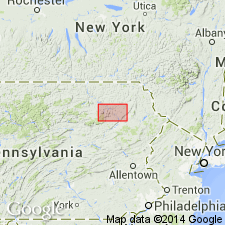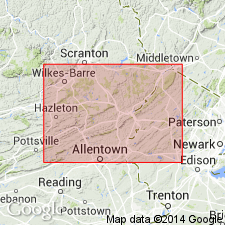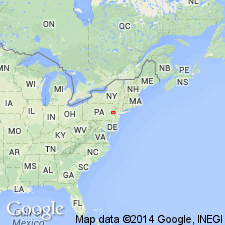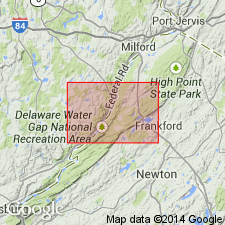
- Usage in publication:
-
- Bossardville limestone
- Modifications:
-
- Named
- Dominant lithology:
-
- Limestone
- AAPG geologic province:
-
- Appalachian basin
Summary:
Bossardville limestone named in Monroe Co., PA, where it is the main quarry lime. Extends to NJ. Unit is almost nonfossiliferous. Upper 65 ft is mostly bluish black layers with thin veins of calcite intersecting in all directions. Basal 25 ft is dark grayish slaty limestone, finely laminated with gray, whitish, blue, etc., and often exhibiting columnar structure. Total thickness 75 to 100 ft. Underlies Deckers Ferry shales and overlies Poxono Island shale. Age is Silurian.
Source: GNU records (USGS DDS-6; Reston GNULEX).

- Usage in publication:
-
- Bossardville limestone
- Modifications:
-
- Overview
- AAPG geologic province:
-
- Appalachian basin
Summary:
Pg. 1183, measured sections. Bossardville limestone. Keyser limestone and its correlatives are underlain in area [southeastern Pennsylvania] in descending order by Bossardville limestone, Poxono Island shale, and Bloomsburg red beds. Where typically developed in vicinity of Delaware Water Gap, the Bossardville consists of three parts. Major (central) beds are blue-black dense limestone. Underlying these beds, at many places, are thin-bedded gray finely straticulate and somewhat shaly limestones. Overlying central beds, locally, is a few feet of thick-bedded impure limestone, weathering yellowish. White (1882) [Pennsylvania Geol. Survey Rpt. Prog., 2nd ser., v. G6] describes green shales, the Deckers Ferry "shale" that present writers have not seen, as lying at top of formation. Poxono Island shale and Bossardville limestone are similar to, and homotaxial with Wills Creek shale and Tonoloway limestone, respectively, of central Pennsylvania and Maryland but lie in a different province; the corresponding formations differ in their time limits; both are believed to be later than Wills Creek shale.
Source: US geologic names lexicon (USGS Bull. 1200, p. 435-436).

- Usage in publication:
-
- Bossardville Limestone*
- Modifications:
-
- Age modified
- AAPG geologic province:
-
- Appalachian basin
Summary:
Pg. 6-9, 68-72. Bossardville Limestone. Age changed from Silurian --to-- Late Sillurian (Cayuga).
Source: Changes in stratigraphic nomenclature, 1967 (USGS Bull. 1274-A, p. A4).

- Usage in publication:
-
- Bossardville Limestone
- Modifications:
-
- Overview
- AAPG geologic province:
-
- Appalachian basin
Summary:
Bossardville Limestone mapped in northwestern New Jersey. Consists of medium-gray to medium-dark-gray, very fine-grained, argillaceous limestone and limestone, weathers medium-bluish-gray. Unit is thin-bedded, laminated to ribbon-textured. Desiccation columns and cracks occur in southwestern part of map area. Total thickness is approximately 100 feet. Lower contact with Poxono Island Formation is gradational and placed at top of uppermost dolomite. Underlies Decker Formation. Age is Late Silurian.
Source: GNU records (USGS DDS-6; Reston GNULEX).
For more information, please contact Nancy Stamm, Geologic Names Committee Secretary.
Asterisk (*) indicates published by U.S. Geological Survey authors.
"No current usage" (†) implies that a name has been abandoned or has fallen into disuse. Former usage and, if known, replacement name given in parentheses ( ).
Slash (/) indicates name conflicts with nomenclatural guidelines (CSN, 1933; ACSN, 1961, 1970; NACSN, 1983, 2005, 2021). May be explained within brackets ([ ]).

